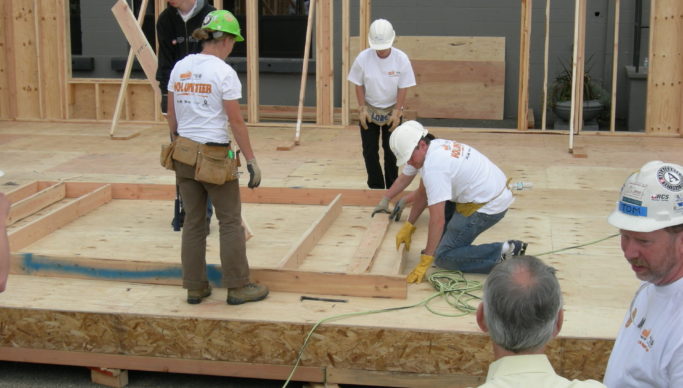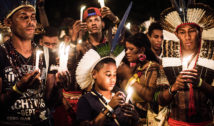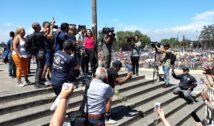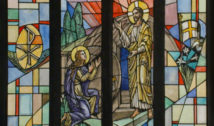
“Let’s Practice Interfaith Dialogue, Oh, And Hand Me That Two-By-Four” – Habitat For Humanity Builds Bridges of Faith – Literally
- By Gladys McBride --
- 15 May 2023 --
A two-by-four is a two-by-four whether you are Christian, Muslim, Jewish or Hindu. So is a monkey wrench, and a hammer and a Phillips-head screwdriver.
As church attendance dwindles and people who identify with a religion lessen, many faith leaders have moved from “Come worship in our house” to “Help us build a house,” reaching out to communities outside their own with the call to service rather than prayer.
A shining example of that shift is Habitat for Humanity, the multifaith charity that has helped more than 46 million worldwide find a home. Everybody’s got to live someplace—no argument with that. And everybody knows that helping your neighbor is a good thing.
So what better way to promote interfaith unity, partnership and understanding than by working side-by-side on a project that requires teamwork and commitment, like building a house for someone who needs one?
Exemplifying the win-win of the idea is the Habitat for Humanity of Greater Nashville that has helped 1,000 families into homeownership.
Jewish, Hindu, Muslim and Christian clergy don’t just mingle their congregations through carpentry and drywall, but through interfaith dialogue and worship services at a local synagogue, Ohabai Sholom.
Those congregations believe very different things about God, observes Kevin Roberts, director of faith relations and mission integration for Habitat for Humanity of Greater Nashville. But they share a common passion for helping their neighbors.
The synagogue’s rabbi, Shana Mackler, says that her temple first got involved in a social action project with two other congregations through a project called Unity Build.
And that one project has blossomed into many, now involving nearly two dozen congregations of different faiths.
“We have stayed involved largely because people love direct action projects, and because it gives us the opportunity to connect with other houses of worship and religious communities in doing good, meaningful work,” she said.
A later entry to the peace-through-construction gambit is Pikes Peak Habitat for Humanity, fresh off dedicating its second interfaith-built residence, an effort shared by Christians, Jews, Muslims, Buddhists and Native Americans. The group also hosts interfaith dialogue events, this past year’s spotlighting the topics of increasing Black homeownership and building an inclusive community.
“We try to pair two faith congregations together from different traditions so that they have the opportunity while on the construction site for the day to get to know one another,” said Chloe Henry, the Faith in Action program manager for Pikes Peak Habitat.
One whose life was shaped in part by Habitat for Humanity’s model is Eboo Patel, president of Interfaith America, who experienced its positive results firsthand working on an overseas Habitat for Humanity project in Hyderabad, India, two decades ago.
Hyderabad at the time was a city scarred by religious violence, and yet when it came to building something for the community, Hindus, Muslims and Christians put their differences aside and worked together.
Inspired, Patel saw that service was the key to unlocking interfaith dialogue. The idea of helping your neighbors, he said, is common among many faiths. No matter what they believe about God, each religion has its version of “the theology of the hammer,” as Habitat founder Millard Fuller called it. According to Patel, there’s something “extra sacred” when people of different faiths work together for the benefit of others.
“Everyone has a story to share,” he said. “You’ve opened up what we called mutually enriching conversations between people of different faiths.”
In an increasingly polarized religious and political climate, where the willingness to give the other person’s point of view a listen, the all-encompassing, all-inclusive simple act of building a house for your neighbor strikes a sympathetic chord with everyone, no matter the name of their deity or the way they worship.
“Radically inclusive” is how Jonathan Reckford, CEO of Habitat for Humanity International, describes the result of the social change strategy, which blends faith and community service.
“My observation is that when people serve together, they focus on what they have in common,” Reckford said. “They focus on shared values — as opposed to when we sit by ourselves online. Then it’s all about how we are different.”
Reckford hopes to take that bridge-building to a new level through a new initiative called Team Up—a Habitat, Catholic Charities, the YMCA and Interfaith America partnership first announced last fall at a White House summit. The idea addresses the nation’s divisions by inviting people to build friendships as they serve together to meet community needs. For Habitat, that will likely involve more intentional community building on the worksite and an increased focus on interfaith cooperation.
Reckford said Habitat’s core Christian identity and commitment to interfaith work go hand-in-hand. Faith in God is at Habitat’s center—but God is “not a border” to keep others out.
Or as Kevin Roberts said, “When you step onto the Habitat build site, and someone puts a paintbrush or a hammer or a saw in your hand, no one asks, ‘Who did you vote for?’” No one asks, ‘Where did you go to church, or did you go at all?’”
Long-time Nashville volunteer Lauren Brooks-Gregory first became involved with Habitat for Humanity as a teenager through Calvary United Methodist Church and is now in her fourth decade with the group. She is happy that construction projects mixed in with interfaith dialogue is a brew that strengthens relationships between people of different faiths. The work gives people who otherwise might never be within a hundred yards of each other the chance to do something together and get to know and understand one another as a happy result.
She sums it up, “Let’s practice interfaith dialogue. But also, hand me that two-by-four.”



















